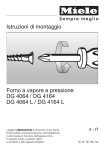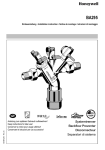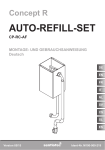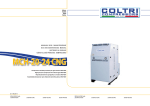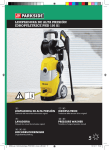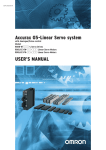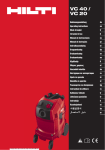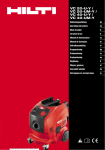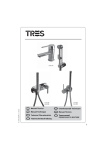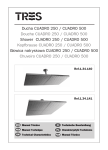Download NK295C
Transcript
NK295C EB-NK295C Rev. A Einbauanleitung • Installation instruction • Notice de montage Istruzioni di montaggio • Instrukcja montażu • Návod na montáž • Beépítési útmutató Anleitung zum späteren Gebrauch aufbewahren! Keep instructions for later use! Conserver la notice pour usage ultérieur! Conservare le istruzioni per uso successivo! Zachowa instrukcj do pózniejszego wykorzystania! Návod uschovejte pro pozdější použití! Az útmutatót őrizze meg a későbbi használatra! Nachfüllkombination Refilling combination Combinaison de remplissage Gruppo di riempimento Zespół napełniający Doplňovací kombinace Utántöltő armatúra D 1. Sicherheitshinweise Federkraft des Regelventils entgegen. Sinkt infolge einer Wasserentnahme der Ausgangsdruck (Hinterdruck) und damit die Kolbenkraft, so öffnet die nun größere Federkraft das Ventil. Der Ausgangsdruck wird wieder höher, bis erneut ein Gleichgewichtszustand zwischen Kolben- und Federkraft erreicht ist. Der Eingangsdruck (Vordruck) hat keinen Einfluss auf das Regelventil im Druckminderer. Druckschwankungen auf der Eingangsseite beeinflussen nicht den Hinterdruck (Vordruckkompensation). 1. Beachten Sie die Einbauanleitung. 2. Benutzen Sie das Gerät • bestimmungsgemäß • in einwandfreiem Zustand • sicherheits- und gefahrenbewusst. 3. Beachten Sie, dass das Gerät ausschließlich für den in dieser Einbauanleitung genannten Verwendungsbereich bestimmt ist. Eine andere oder darüber hinausgehende Benutzung gilt als nicht bestimmungsgemäß. 4. Beachten Sie, dass alle Montage-, Inbetriebnahme, Wartungs- und Justagearbeiten nur durch autorisierte Fachkräfte ausgeführt werden dürfen. 5. Lassen Sie Störungen, welche die Sicherheit beeinträchtigen können, sofort beseitigen. 3. Verwendung 2. Funktionsbeschreibung Wasser ohne Inhibitoren Vordruck min. 1,5 bar max. 10,0 bar Hinterdruck 1,5-6 bar Flüssigkeitskatagorie 3 (wenig giftige Stoffe) Systemtrenner CA Die Nachfüllkombination vereinigt Systemtrenner, Druckminderer und Absperrkugelhähne in einem Gerät. Der Systemtrenner ist nach DIN EN 1717 eine Sicherungsarmatur und verhindert ein Rückdrücken, Rückfließen und Rücksaugen von verunreinigtem Wasser in die Versorgungsleitung, in fremde Anlagen oder andere Anlagenteile. Der Systemtrenner ist in drei Kammern (Vor-, Mittel,und Hinterdruckkammer) unterteilt. Erfolgt keine Wasserentnahme ist der Systemtrenner unter Betriebsdruck in Ruhestellung. Die ein- und ausgangsseitigen Rückflussverhinderer und das Ablassventil sind geschlossen. Bei Wasserentnahme ist der Systemtrenner in Durchflussstellung. Die ein- und ausgangsseitigen Rückflussverhinderer sind geöffnet und das Ablassventil geschlossen. Ist der Differenzdruck zwischen Mittel- und Vordruckkammer kleiner als 10% des Eingangsdrucks, geht der Systemtrenner in Trennstellung (rücksaugen). Der eingangsseitige Rückflussverhinderer schließt und das Ablassventil öffnet. Es gibt keine Möglichkeit zur messbaren Kontrolle der Sicherungseinrichtung. Der Druckminderer setzt den eingangsseitigen Druck (Vordruck) auf den gewünschten Druck auf der Ausgangsseite (Hinterdruck) herab. Federbelastete Druckminderer arbeitet nach dem Kraftvergleichssystem. Der Kolbenkraft wirkt die Honeywell GmbH Medium 4. Technische Daten Einbaulage waagrecht mit Ablaufanschluss nach unten Betriebstemperatur max. 65°C Ablaufanschluss HT 40 Anschlussgröße 1/2" AG 5. Lieferumfang Die Nachfüllkombination besteht aus: • Absperrarmaturen, ein- und ausgangsseitig • Kompletter Systemtrenner mit Ablaufanschluss, Kartuscheneinsatz (inkl. integriertem Rückflussverhinderer und Abblassventil, eingangsseitig), integriertem Schmutzfänger eingangsseitig (Maschenweite ca. 0,5 mm) und Rückflussverhinderer ausgangsseitig • Kompletter Druckminderer mit Ventileinsatz, Federhaube (inkl. Verstellgriff), Sollwertfeder und Manometer 6. Montage 6.1 Einbauhinweise • Einbau in waagrechte Rohrleitung mit Ablaufanschluss nach unten • Der Einbau darf nicht in Räumen oder Schächten erfolgen, in denen giftige Gase oder Dämpfe auftreten und die überflutet werden können (Hochwasser) 2 MU1H-1548GE23 R0609 D 8. Instandhaltung • Der Einbauort muss gut belüftet sein • Der Einbauort muss frostsicher und gut zugänglich sein o Vereinfacht Wartung und Reinigung o Manometer am Druckminderer kann gut beobachtet werden • Beruhigungsstrecke von mindestens 5xDN nach Nachfüllkombination vorsehen (entsprechend DIN 1988, Teil 5) • Schmutzfänger in der Nachfüllkombination integriert - kein separater Schmutzfänger notwendig o Nachfüllkombination wird vor Funktionsstörungen und Korrosionsschäden durch eingespülte Fremdkörper, z.B. Schweißperlen, Dichtungsmaterial, Späne oder Rost geschützt 6.2 Montageanleitung Um stagnierendes Wasser zu vermeiden ist die Nachfüllkombination möglichst direkt an die Versorgungsleitung anzuschließen! Bei der Montage gelten die Regeln der Trinkwasserverordnungen! 1. Rohrleitung gut durchspülen 2. Isolierschale abnehmen 3. Nachfüllkombination einbauen o Einbau in waagrechte Rohrleitung mit Ablaufanschluss nach unten o Durchflussrichtung beachten (Pfeilrichtung) o spannungs- und biegemomentfrei einbauen 4. Ablaufleitung an Ablaufanschluss anschließen (Kunststoffrohr HT 40) 5. Isolierschale montieren Wir empfehlen einen Wartungsvertrag mit einem Installationsunternehmen abzuschließen Entsprechend DIN EN 1717 muss eine regelmäßige Wartung durchgeführt werden. 8.1 Inspektion 8.1.1 Druckminderer Intervall: einmal jährlich Durchführung durch ein Installationsunternehmen oder den Betreiber. 1. Absperrkugelhahn ausgangsseitig an der Nachfüllkombination schließen 2. Hinterdruck am Manometer bei Nulldurchfluss kontrollieren o Steigt der Druck langsam an, ist die Armatur eventuell verschmutzt oder defekt. Führen Sie in diesem Fall eine Wartung und Reinigung durch 3. Absperrkugelhahn ausgangsseitig an der Nachfüllkombination langsam öffnen 8.1.2 Systemtrenner Intervall: einmal jährlich Durchführung durch ein Installationsunternehmen oder den Betreiber. 1. Absperrarmatur eingangsseitig schließen 2. Entleerung am Absperrkugelhahn eingangsseitig öffnen o Ist der Differenzdruck zwischen Mittel- und Vordruckkammer kleiner als 10% vom Eingangsdruck, geht der Systemtrenner in Trennstellung (rücksaugen). Der eingangsseitige Rückflussverhinderer schließt und das Ablassventil öffnet. Öffnet das Ablassventil nicht Nachfüllkombination ersetzen! 3. Entleerung am Absperrkugelhahn eingangsseitig schließen 4. Absperrarmatur eingangsseitig langsam öffnen 8.1.3 Dichtheit Intervall: einmal jährlich Durchführung durch ein Installationsunternehmen oder den Betreiber. 1. Entnahmestelle öffnen. Nachfüllkombination geht in Durchflussstellung. 2. Visuelle Kontrolle Nachfüllkombination auf exakten Sitz und Dichtheit. Wasseraustritt an Nachfüllkombination Technische Kundenberatung anrufen! 7. Inbetriebnahme 7.1 Hinterdruck einstellen 1. Absperrarmaturen ein- und ausgangsseitig schließen 2. Druckfeder entspannen o Beiliegenden Verstellgriff einstecken und nach links drehen 3. Entleerung am Absperrkugelhahn ausgangsseitig öffnen und schließen. Druckminderer wird druckentlastet. 4. Absperrarmatur eingangsseitig langsam öffnen 5. Verstellgriff drehen, bis Manometer gewünschten Wert anzeigt. 6. Verstellgriff abziehen 7. Absperrarmatur ausgangsseitig langsam öffnen MU1H-1548GE23 R0609 3 Honeywell GmbH D 9. Entsorgung • Gehäuse aus entzinkungsbeständigem Messing • Ablaufanschluss, Kartuscheneinsatz, Ventileinsatz und Federhaube aus hochwertigem Kunststoff • Rückflussverhinderer aus hochwertigem Kunststoff • Dichtelemente aus NBR • Sollwertfeder aus Federstahl • Isolierschale aus EPP Die örtlichen Vorschriften zur ordnungsgemäßen Abfallverwertung bzw. Beseitigung beachten! 10. Störungen / Fehlersuche Störung Ursache Behebung Schlagende Geräusche Rückflussverhinderer defekt Technische Kundenberatung anrufen Wasseraustritt an Nachfüllkom- Dichtelemente verschmutzt oder defekt bination Technische Kundenberatung anrufen Kein oder zu wenig Durchfluss Nachfüllkombination nicht in Durchflussrichtung montiert Nachfüllkombination in Durchflussrichtung montieren (Pfeilrichtung auf Gehäuse beachten) Absperrkugelhähne vor oder nach Nachfüllkombination nicht ganz geöffnet Absperrkugelhähne ganz öffnen Entleerungen an Absperrkugelhähnen vor Entleerungen ganz schließen und nach Nachfüllkombination nicht ganz geschlossen Nachfüllkombination schaltet nicht auf Durchfluss Druckminderer nicht auf gewünschten Hinterdruck eingestellt Hinterdruck einstellen Versorgungsdruck in Verbindung mit Ansprechdruck überprüfen Technische Kundenberatung anrufen Nachfüllkombination öffnet und nachgeschaltete Anlage undicht schließt in kurzen Zeitabständen Rückflussverhinderer verschmutzt oder (pumpen) defekt Honeywell GmbH 4 Anlage überprüfen Technische Kundenberatung anrufen MU1H-1548GE23 R0609 GB 1. Safety Guidelines ding to a system of force balance. The piston force works against the spring force of the control valve. If the outlet pressure (back pressure) drops as a consequence of drawing water, leading to the piston force dropping as well, the now greater spring force will open the valve. The outlet pressure is higher again until the balance between piston and spring force is once again achieved. The inlet pressure has no influence in either opening or closing of the valve. Because of this, inlet pressure fluctuation does not influence the outlet pressure, thus providing inlet pressure balancing. 1. Follow the installation instructions. 2. Use the appliance • according to its intended use • in good condition • with due regard to safety and risk of danger. 3. Note that the appliance is exclusively for use in the applications detailed in these installation instructions. Any other use will not be considered to comply with requirements and would invalidate the warranty. 4. Please take note that any assembly, commissioning, servicing and adjustment work may only be carried out by authorized persons. 5. Immediately rectify any malfunctions which may influence safety. 3. Application Medium Inlet pressure Outlet pressure Liquid category Backflow Preventer 2. Functional description The refilling combination combines backflow preventer, pressure reducing valve and ball valves in one appliance. The backflow preventer is a safety device in accordance with EN 1717 to protect systems against back pressure, back flow and back syphonage of nonpotable water into service pipe, plants and equipments. The backflow preventer is separated in three chambers (inlet, middle and outlet chamber). If no water is drawn from the downstream system, the backflow preventer is in normal position. The up- and downstream check valves and the discharge valve are closed. If water is drawn from the downstream system, the backflow preventer is in flow position. The check valves up- and downstream are opened and the discharge valve is closed. If the differential pressure between middle and inlet chambers is less than 10 % of the inlet pressure, the system disconnector moves into disconnect position (back suction). The inlet side backflow preventer closes and the discharge valve opens. There is no possibility to control the safety function by measuring. The pressure reducing valve reduces the pressure on the inlet side (admission pressure) to the level of the desired pressure on the outlet side (outlet pressure) in individual cases. Spring-loaded pressure reducing valves work accorHoneywell GmbH Water without inhibitors min. 1.5 bar max. 10.0 bar 1.5-6 bar 3 (slightly toxic materials) 4. Technical data Installation position horizontal pipework with discharge connection directed downwards Operating temperature max. 65°C Connection size HT 40 Discharge Connection size 1/2" AG 5. Scope of delivery The refilling combination consists of: • Shut off valve, up- and downstream • Complete backflow preventer with discharge connection, valve cartridge (incl. integrated check valve and discharge valve, upstream), integrated strainer upstream (mesh size approx. 0,5 mm) and check valve downstream • Complete pressure reducing valve with valve insert, spring hood (including adjuster knob), setpoint spring and pressure gauge 6. Assembly 6.1 Installations Guidelines • Install in horizontal pipework with discharge connection directed downwards • The installation may not take place in areas or ducts where poisonous gases or vapours may be present or where flooding can occur • The installation location must be ventilated well • The installation location should be protected against frost and be easily accessible 5 MU1H-1548GE23 R0609 GB 8. Maintenance o Simplified maintenance and cleaning o Pressure gauge at the pressure reducing valve can be read off easily • Provide a straight section of pipework of at least five times the nominal valve size after the pressure reducing valve (in accordance with DIN 1988, Part 5) • The refilling combination has an integrated strainer - no separate strainer necessary o Refilling combination is protected against malfunction and corrosion damage resulting from ingress of foreign bodies, e.g. welding beads, sealing materials, metal cuttings and rust 6.2 Assembly instructions To avoid stagnating water, the refilling combination must be connected as directly as possible to the supply line! The guidelines of drinking water regulations apply for installation! 1. Thoroughly flush pipework 2. Remove the isolation shell 3. Install refilling combination • Install in horizontal pipework with discharge connection directed downwards • Note flow direction (indicated by arrow) o Install without tension or bending stresses 4. Attach drain pipe to discharge connection (plastic pipe HT 40) 5. Install isolation shell We recommend a planned maintenance contract with an installation company In accordance with DIN EN 1717 a regular maintenance must be taken. 8.1 Inspection 8.1.1 Pressure reducing valve Interval: once a year To be carried out by an installation company or the operator. 1. Close ball valve on the outlet side of the refilling combination 2. Check outlet pressure on pressure gauge when no flow is occurring o If the pressure is increasing slowly, the valve may be dirty or defective. In this instance, carry out servicing and cleaning 3. Slowly open the ball valve on the outlet side of the refilling combination 8.1.2 System disconnector Interval: once a year To be carried out by an installation company or the operator. 1. Close shutoff valve on inlet 2. Open the drain point on the inlet side of the shut-off ball valve. o If the differential pressure between middle and inlet chambers is less than 10 % of the inlet pressure, the system disconnector moves into disconnect position (back suction). The inlet side backflow preventer closes and the discharge valve opens. Does not open the discharge valve Replace refilling combination! 3. Close the drain point on the inlet side of the shut-off ball valve 4. Slowly open shutoff valve on inlet 7. Commissioning 7.1 Setting outlet pressure 1. Close shut off valve on inlet and outlet 2. Slacken tension in compression spring o Insert the available adjuster knob and turn to the left 3. Open and close drain cock at the shut off ball valve downstream. Pressure reducing valve is decompressed. 4. Slowly open shutoff valve on inlet 5. Turn adjuster knob until the manometer shows the desired value. 6. Remove adjuster knob 7. Slowly open shutoff valve on outlet MU1H-1548GE23 R0609 6 Honeywell GmbH GB 9. Disposal 8.1.3 Leak-tightness Interval: once a year To be carried out by an installation company or the operator. 1. Open sampling point. Refilling combination changes into flow position. 2. Optical control refilling combination of location and tightness. If water exits at the refilling combination, call the technical customer support service! • Dezincification-resistant brass housing • Discharge connection, valve cartridge, valve insert and spring hood in high-grade synthetic material • High-grade synthetic material check valve • Seals in NBR • Spring steel adjustment spring • Isolation shell in EPP Observe the local requirements regarding correct waste recycling/disposal! 10. Troubleshooting Problem Beating sounds Cause Remedy Non return valve is faulty Call our Technical Customer Services Water is escaping from refilling Sealing elements are contaminated or combination worn Call our Technical Customer Services No or too small water flow rate Refilling combination is not fitted in flow direction Fit refilling combination in flow direction (note direction of arrow on housing) Ball valves up- or downstream of refilling Open ball valves entirely combination are not fully open Drain cocks at the shut off ball valves upand downstream of the refilling combina- Close drain cocks tion are not fully close Pressure reducing valve is not set to the desired outlet pressure Refilling combination change not into flow position Set outlet pressure Check supply pressure with reaction pres- Call our Technical Customer sure Services Check plant Refilling combination opens and plant downstream leaky closes in short time intervals Call our Technical Customer Non return valve is contaminated or worn (pump) Services Honeywell GmbH 7 MU1H-1548GE23 R0609 F 1. Consignes de sécurité Le réducteur de pression à ressort fonctionne selon le système de comparaison des forces. La puissance du ressort s'oppose à la puissance du piston. Si la pression de sortie (pression aval) et donc la puissance du piston chutent après une prise d'eau, la puissance supérieure du ressort ouvre la soupape. La pression de sortie remonte jusqu'à atteindre un état d'équilibre entre la puissance du piston et celle du ressort. La pression d'entrée (pression amont) n'a pas d'effet sur l'organe régulateur dans le détendeur. Les fluctuations éventuelles de pression à l'entrée n'ont aucune répercussion sur la pression aval (effet de compensation de la pression amont). 1. Suivre les indications de la notice de montage. 2. En ce qui concerne l'utilisation de l'appareil • Utiliser cet appareil conformément aux données du constructeur • Maintenir l'appareil en parfait état • Respectez les consignes de sécurité 3. Il faut noter que cet équipement ne peut être mis en oeuvre que pour les conditions d'utilisation mentionnées dans cette notice. Toute autre utilisation, ou le non respect des conditions normales d'utilisation, serait considérée comme non conforme. 4. Observer que tous les travaux de montage, de mise en service, d'entretien et de réglage ne pourront être effectués que par des spécialistes autorisés. 5. Prendre des mesures immédiates en cas d'anomalies mettant en cause la sécurité. 3. Mise en oeuvre Fluide Pression amont Pression aval Catégorie de liquide Disconnecteur CA 2. Description fonctionnelle La combinaison de remplissage réunit le séparateur de système, le réducteur de pression et le robinet de fermeture en un seul appareil. Le disconnecteur est un robinet de sécurité conforme à la norme DIN EN 1717 et prévient les retours de pression, d'écoulement et d'aspiration des eaux usées dans la conduite d'alimentation, dans les autres installations ou dans d'autres parties de l'installation. Le disconnecteur est divisé en trois chambres (chambre sous pression avant, médiane et arrière). Si aucune prise d'eau ne se produit, le séparateur de système est sous pression en position normale. Les clapets anti-retour du côté de l'admission et de la sortie et la vanne de purge sont fermés. En cas de prise d'eau, le disconnecteur est en position d'écoulement. Les clapets anti-retour du côté de l'admission et de la sortie sont ouverts et la vanne de purge est fermée. Si la pression différentielle entre la chambre médiane et la chambre avant est inférieure de 10% à la pression d'arrivée, le disconnecteur passe en position de sectionnement (retour d'aspiration). Le clapet anti-retour du côté de l'admission se ferme et la vanne de purge s'ouvre. Il n'est pas possible d'effectuer des contrôles mesurés du dispositif de sécurité. Le réducteur de pression réduit la pression d'admission (pression amont) au niveau souhaité du côté de la sortie (pression aval). Honeywell GmbH Eau sans inhibiteurs 1,5 bar mini 10,0 bar maxi 1,5 à 6 bar 3 (peu de produits toxiques) 4. Caractéristiques Position de montage horizontal avec raccord d'évacuation vers le bas Température de max. 65°C fonctionnement Raccord d'évacuation HT 40 Dimensions de 1/2" AG raccordement 5. Contenu de la livraison La combinaison de remplissage comprend: • Les robinets d'arrêt, côté admission et côté sortie • Le disconnecteur complet avec raccord d'évacuation, cartouche (avec clapet anti-retour et soupape d'évacuation intégrés, côté admission), panier filtrant intégré côté admission (taille de la maille env. 0,5 mm) et clapet anti-retour côté sortie • Réducteur de pression complet avec garniture de soupape, coiffe de ressort (avec bouton de réglage), ressort de tarage et manomètre 6. Montage 6.1 Dispositions à prendre • Montage dans une conduite horizontale avec raccord de sortie vers le bas • Le montage ne doit pas être effectué dans des locaux ou des conduits dans lesquels des gaz ou des vapeurs toxiques apparaissent et qui peuvent 8 MU1H-1548GE23 R0609 F être ventilés (montée de l'eau) • L'emplacement du montage doit être bien aéré • L'emplacement du montage doit être à l'abri du gel et rester facilement accessible. o Pour simplifier l'entretien et le nettoyage o Le manomètre sur le réducteur de pression est facilement lisible • Prévoir un parcours de stabilisation de 5 x DN au minimum après la combinaison de remplissage (selon DIN 1988, 5ème partie) • Panier filtrant intégré dans la combinaison de remplissage - pas de panier filtrant séparé nécessaire o La combinaison de remplissage est protégé des dysfonctionnements et des dégâts liés à la corrosion provoqués par l'infiltration de corps étrangers, par ex. des gouttes de transpiration, des matériaux d'étanchéité, des copeaux ou de la rouille 6.2 Instructions de montage Pour éviter l'eau stagnante la combinaison de remplissage doit être raccordée le plus près possible sur la conduite d'alimentation! Au cours du montage, les règles des directives sur l'eau potable s'appliquent! 1. Bien rincer la conduite 2. Retirer l'enveloppe isolante 3. Monter la combinaison de remplissage • Montage dans une conduite horizontale avec raccord de sortie vers le bas • Veillez à la direction de l'écoulement (direction de la flèche) o Vérifier l'absence de contraintes anormales en traction et en flexion 4. Raccorder la conduite de sortie au raccordement (tuyau en plastique HT 40) 5. Monter l'enveloppe isolante 5. Tourner la poignée de réglage jusqu’à ce que le manomètre affiche la valeur souhaitée 6. Retirer la poignée de réglage 7. Ouvrir lentement la vanne d'isolement côté sortie 8. Maintenance Nous recommandons de conclure un contrat d'entretien avec un installateur Conformément à la DIN EN 1717, une maintenance régulière soit être réalisée. 8.1 Inspection 8.1.1 Décompresseur Intervalle : une fois par an Réalisation par une entreprise d'installation ou l'exploitant. 1. Fermer le robinet de fermeture sur la combinaison de remplissage du côté de la sortie 2. Contrôler la pression aval sur le manomètre avec un écoulement à zéro o Si la pression augmente lentement, la robinetterie est éventuellement sale ou défectueuse. Effectuer dans ce cas un entretien et un nettoyage 3. Ouvrir lentement le robinet de fermeture sur la combinaison de remplissage 8.1.2 Disconnecteur Intervalle : une fois par an Réalisation par une entreprise d'installation ou l'exploitant. 1. Fermer la robinet de fermeture du côté de l'entrée 2. Ouvrir le vidage sur le robinet de fermeture côté admission o Si la pression différentielle entre la chambre médiane et la chambre avant est inférieure de 10% à la pression d'arrivée, le disconnecteur passe en position de sectionnement (retour d'aspiration). Le clapet anti-retour du côté de l'admission se ferme et la vanne de purge s'ouvre. Si la vanne de purge ne s'ouvre pas, remplacer la combinaison de remplissage! 3. Fermer le vidage sur le robinet de fermeture côté admission 4. Ouvrir lentement la vanne d'isolement côté entrée 7. Mise en service 7.1 Réglage de la pression aval 1. Fermer la vanne d'isolement côté entrée et sortie 2. Détendre le ressort de pression o Fixer le bouton de réglage fourni et le tourner vers la gauche 3. Ouvrir et fermer le vidage sur le robinet de fermeture du côté sortie. Le réducteur de pression est dépressurisé. 4. Ouvrir lentement la vanne d'isolement côté entrée MU1H-1548GE23 R0609 9 Honeywell GmbH F 9. Matériel en fin de vie 8.1.3 Étanchéité Intervalle : une fois par an Réalisation par une entreprise d'installation ou l'exploitant. 1. Ouvrir le point de prélèvement. La combinaison de remplissage passe en position d'écoulement. 2. Contrôle visuel de la position exacte et de l'étanchéité de la combinaison de remplissage. Écoulement d'eau sur la combinaison de remplissage Appeler le service technique aprèsvente! • Corps en laiton résistant à la dézincification • Raccord d'évacuation, cartouche, garniture de soupape et coiffe de ressort en matière plastique de haute qualité • Clapet anti-retour en matière plastique de haute qualité • Eléments d'étanchéité en NBR • Ressort de la valeur théorique en acier à ressort • Enveloppe isolante en polypropylène expansé Se conformer à la réglementation pour l'élimination des équipements industriels en fin de vie vers les filières de traitement autorisées! 10. Défaut / recherche de panne Panne Cause Remède Bruits répétés Clapet anti-retour défectueux Contacter le service techn. clients Écoulement d'eau sur la combin- Éléments d'étanchéité sales ou défectueux Contacter le service techn. clients aison de remplissage Peu ou trop peu d'écoulement Combinaison de remplissage pas montée Monter la combinaison de remplisdans le sens du débit sage dans le sens du débit (respecter le sens de la flèche sur le corps) Robinet de fermeture pas complètement Ouvrir complètement le robinet de ouvert avant ou après la combinaison de fermeture remplissage Vidages sur les robinets de fermeture avant Fermer complètement les vidages et après la combinaison de remplissage pas complètement fermés Réglage inadapté de la pression aval du détendeur La combinaison de remplissage Contrôler la pression d'alimentation en ne démarre pas avec le débit. fonction de la pression de démarrage La combinaison de remplissage L'installation raccordée en aval fuit s'ouvre et se ferme à intervalles Clapet anti-retour sale ou défectueux rapprochés (pompage) Honeywell GmbH 10 Régler la pression aval Contacter le service techn. clients Contrôler l'installation Contacter le service techn. clients MU1H-1548GE23 R0609 I 1. Avvertenze di sicurezza secondo il sistema di contrasto delle forze. La forza dello stantuffo contrasta la forza della molla della valvola di regolazione. Se in seguito a un prelievo di acqua diminuisce la pressione di uscita (pressione a valle) e quindi la forza dello stantuffo, la forza più alta della molla provoca l'apertura della valvola. La pressione di uscita aumenta nuovamente quando viene ristabilita una situazione di equilibrio tra forza dello stantuffo e forza della molla. La pressione di ingresso (pressione a monte) non ha alcun influsso sulla valvola di regolazione nel riduttore di pressione. Oscillazioni di pressione sul lato di ingresso non influenzano la pressione a valle (compensazione della pressione a monte) 1. Rispettare le istruzioni di montaggio. 2. Utilizzare l'apparecchio • secondo la destinazione d'uso • in uno stato perfetto • in modo sicuro e consapevoli dei pericoli connessi 3. Si prega di considerare che l'apparecchio è realizzato esclusivamente per il settore d'impiego riportato nelle presenti istruzioni d'uso. Un uso differente o diverso da quello previsto è da considerarsi improprio. 4. Osservare che tutti i lavori di montaggio, di messa in funzione, di manutenzione e di regolazione devono essere eseguiti soltanto da tecnici specializzati e autorizzati. 5. I guasti che potrebbero compromettere la sicurezza devono essere risolti immediatamente. 3. Uso Mezzo acqua senza inibitori Pressione a monte min. 1,5 bar max. 10,0 bar Pressione a valle 1,5-6 bar Categoria liquidi sepa-3 (sostanze leggermente ratore di sistema CA tossiche) 2. Descrizione del funzionamento Il gruppo di riempimento riunisce in un'unico apparecchio il separatore di sistema, il riduttore di pressione e i rubinetti d'intercettazione. Secondo la norma DIN EN 1717, il separatore di sistema è un raccordo di sicurezza che impedisce il ritorno dell'acqua inquinata nella tubazione di alimentazione per effetto di inversione di pressione, riflusso o sifonaggio, in impianti esterni o in altre parti dell'impianto. Il separatore di sistema è suddiviso in tre camere (camera di pressione a monte, intermedia e a valle). Se non avviene alcun prelievo dell'acqua il separatore di sistema si trova a pressione di esercizio in posizione di base. Gli impeditori di riflusso in ingresso e in uscita e la valvola di scarico sono chiusi. In caso di prelievo dell'acqua il separatore di sistema si trova in posizione di flusso. Gli impeditori di riflusso in ingresso e in uscita sono aperti e la valvola di scarico è chiusa. Se la differenza di pressione tra camera di pressione intermedia e a monte è inferiore al 10% della pressione d'ingresso, il separatore di sistema si porta in posizione di separazione (riflusso). L'impeditore di riflusso in ingresso si chiude e la valvola di scarico si apre. Non esiste una possibilità di controllare, tramite misurazioni, i dispositivi di sicurezza. Il riduttore di pressione riduce la pressione in ingresso (pressione a monte) ottenendo il valore desiderato per la pressione in uscita (pressione a valle). Il riduttore di pressione caricato a molla lavora Honeywell GmbH 4. Dati tecnici Posizione di installazione Temperatura di esercizio Attacco dello scarico Dimensioni attacchi orizzontale con attacco dello scarico in basso max. 65°C HT 40 1/2" FE 5. Fornitura Il gruppo di riempimento è composto da: • Raccordi d'intercettazione, lato ingresso e uscita • Separatore di sistema completo di attacco di scarico, inserto cartuccia (incl. impeditore di riflusso e valvola di scarico integrati, lato ingresso), filtro integrato lato ingresso (larghezza maglie circa 0,5 mm) e impeditore di riflusso lato uscita • Riduttore di pressione completo di inserto valvola, coperchio molla (incl. maniglia di regolazione), molla valore nominale e manometro 6. Montaggio 6.1 Istruzioni di installazione • Montaggio nelle tubazioni orizzontali con attacco dello scarico verso il basso • È vietata l'installazione in locali o pozzetti in cui si possano generare gas o vapori nocivi e soggetti a allagamento (acqua di piena) • Il luogo di installazione deve essere ben ventilato 11 MU1H-1548GE23 R0609 I 8. Manutenzione • Il luogo di montaggio deve essere resistente al gelo e ben accessibile o Rende più semplice la manutenzione e la pulizia o Il manometro del riduttore di pressione deve essere facilmente controllabile • Prevedere un percorso di calma di 5xDN a valle del gruppo di riempimento (secondo DIN 1988, parte 5) • Il filtro è già integrato nel gruppo di riempimento (non è necessario un filtro separato) o Il gruppo di riempimento viene protetto da eventuali malfunzionamenti o corrosione causati da corpi estranei, p.es. perle di saldatura, resti di sigillante, trucioli o ruggine 6.2 Istruzioni di montaggio Per evitare la formazione di acqua stagnante, se possibile il gruppo di riempimento deve essere collegato direttamente alla linea di alimentazione! Per il montaggio valgono le regole previste dalle norme sull'acqua potabile! 1. Sciacquare bene la tubazione. 2. Staccare la copertura isolante 3. Installare il gruppo di riempimento • Montaggio nelle tubazioni orizzontali con attacco dello scarico verso il basso • Osservare la direzione di flusso (direzione della freccia) o senza tensione e momento flettente 4. Collegare il tubo di scarico all'attacco dello scarico (tubo di plastica HT 40) 5. Montare la copertura isolante Consigliamo di stipulare un contratto di manutenzione con un'azienda di installazione In conformità alla norma DIN EN 1717 bisogna eseguire una manutenzione periodica. 8.1 Ispezione 8.1.1 Riduttore di pressione Frequenza: una volta l'anno Esecuzione tramite un'impresa di installazioni o il gestore. 1. Chiudere il rubinetto di chiusura in uscita sul gruppo di riempimento 2. Controllare la pressione a valle sul manometro a flusso zero o Se la pressione sale lentamente, la raccorderia è eventualmente intasata o difettosa. Eseguire in questo caso una manutenzione e una pulizia 3. Aprire lentamente il rubinetto di chiusura in uscita sul gruppo di riempimento 8.1.2 Separatore di sistema Frequenza: una volta l'anno Esecuzione tramite un'impresa di installazioni o il gestore. 1. Chiudere l'armatura di chiusura lato entrata 2. Aprire lo sfiato del rubinetto d'intercettazione lato ingresso o Se la differenza di pressione tra camera di pressione intermedia e a monte è inferiore al 10% della pressione d'ingresso, il separatore di sistema si porta in posizione di separazione (riflusso). L'impeditore di riflusso in ingresso si chiude e la valvola di scarico si apre. Se la valvola di scarico non si apre, sostituire il gruppo di riempimento! 3. Chiudere lo sfiato del rubinetto d'intercettazione lato ingresso 4. Aprire il raccordo di blocco sul lato di ingresso. 7. Messa in funzione 7.1 Regolazione della pressione a valle 1. Chiudere i raccordi d'intercettazione sul lato ingresso e uscita 2. Allentare la molla a pressione. o Montare la maniglia di regolazione fornita in dotazione e ruotarla verso sinistra 3. Aprire lo sfiato del rubinetto d'intercettazione lato uscita e richiuderlo. Il riduttore di pressione viene depressurizzato. 4. Aprire il raccordo di blocco sul lato di ingresso. 5. Girare il manico di regolazione, fino a quando il manometro indica il valore desiderato. 6. Smontare la maniglia di regolazione 7. Aprire il raccordo di blocco sul lato di uscita. MU1H-1548GE23 R0609 12 Honeywell GmbH I 9. Smaltimento 8.1.3 Tenuta Frequenza: una volta l'anno Esecuzione tramite un'impresa di installazioni o il gestore. 1. Aprire il punto di prelievo. Il gruppo di riempimento si porta in posizione di flusso. 2. Sottoporre il gruppo di riempimento a un controllo visivo e accertarsi che sia correttamente fissato in sede e che non perda. Se vengono rilevate perdite di acqua dal gruppo di riempimento, contattare l'assistenza tecnica clienti! • Corpo in ottone resistente alla dezincatura • Attacco di scarico, inserto cartuccia, inserto valvola e coperchio della molla in plastica pregiata • Impeditore di riflusso in plastica pregiata • Elementi di guarnizione di NBR • Molle del valore nominale in acciaio per molle • Copertura isolante in EPP Rispettare le norme locali relative al riciclaggio o allo smaltimento a regola d'arte di rifiuti! 10. Guasti / Ricerca guasti Guasto Causa Risoluzione Rumori battenti Impeditore di riflusso difettoso Contattare telefonicamente il servizio consulenza tecnico Perdita di acqua dal gruppo di Guarnizioni sporche o difettose riempimento Contattare telefonicamente il servizio consulenza tecnico Flusso assente o troppo basso Gruppo di riempimento non montato nella Montare il gruppo di riempimento direzione di flusso nella direzione di flusso (attenersi alla direzione della freccia sul corpo) Rubinetti di chiusura a monte e a valle del Aprire completamente i rubinetti gruppo di riempimento non aperti completamente Gli sfiati dei rubinetti d'intercettazione a Chiudere completamente gli sfiati monte e a valle del gruppo di riempimento non sono completamente chiusi Riduttore della pressione non impostato alla pressione a valle desiderata Regolare la pressione a valle Il gruppo di riempimento non si Controllare la pressione di alimentazione in Contattare telefonicamente il porta il posizione di flusso combinazione con la pressione di reazione servizio consulenza tecnico Il gruppo di riempimento si apre L'impianto collegato a valle non è a tenuta Controllare l'impianto e si chiude a brevi intervalli Impeditore di riflusso sporco o difettoso Contattare telefonicamente il (pompaggio) servizio consulenza tecnico Honeywell GmbH 13 MU1H-1548GE23 R0609 PL 1. Wskazówki bezpieczeDstwa Reduktor ciśnienia obniża ciśnienie wlotowe (ciśnienie wstępne) do odpowiedniego poziomu ciśnienia na stronie wylotowej (ciśnienie wtórne). Sprężynowy reduktor ciSnienia pracuje w oparciu o zasadę równowagi sił. Siła działająca na tłok przeci wdziała sile sprężyny zaworu regulacyjnego. Gdy na skutek poboru wody zmniejsza się ciSnienie wylotowe (ciSnienie wyjSciowe) a tym samym siła działająca na tłok, następuje zwiększenie siły sprężyny powodując otwarcie zaworu. CiSnienie wylotowe roSnie, aż do ponownego uzyskania stanu równowagi pomiędzy siłą działającą na tłok a siłą sprężyny. Ci[nienie wej[ciowe (ci[nienie wstpne) nie ma |adnego wpBywu na zawór regulacyjny w reduktorze ci[nienia. Wahania ci[nienia po stronie wej[ciowej nie maj wpBywu na ci[nienie koDcowe (kompensacja ci[nienia wstpnego) 1. Przestrzegać instrukcji montażu. 2. Proszę użytkować przyrząd • zgodnie z jego przeznaczeniem • w nienagannym stanie • ze świadomością bezpieczeństwa i zagrożeń 3. Proszę uwzględnić, że przyrząd przeznaczony jest wyłącznie dla zakresu zastosowania określonego w niniejszej instrukcji montażu. Każde inne lub wykraczające poza to użytkowanie uznawane jest jako niezgodne z przeznaczeniem. 4. Proszę uwzględnić, że wszystkie prace montażowe mogą być wykonywane tylko przez autoryzowany personel fachowy. 5. Wszystkie te zakłócenia, które mogą naruszyć bezpieczeństwo należy natychmiast usunąć. 2. Opis funkcji 3. Zastosowanie Zespół napełniający łączy w jednym urządzeniu zespół odcinający, reduktor ciSnienia oraz kulowe zawory odcinające. Izolator przepływu zwrotnego, według normy DIN EN 1717, jest armaturą zabezpieczającą i ogranicza wsteczne ciśnienia, przepływy zwrotne i zasysanie zwrotne zanieczyszczonej wody w instalacjach zasilających, w instalacjach zewnętrznych i innych częściach instalacji. Izolator przepływu zwrotnego podzielony jest na trzy komory ciśnieniowe (wlotową - ciśnienia wstępnego, środkową - ciśnienia średniego i wylotową - ciśnienia wtórnego). Jeśli nie zachodzi pobieranie wody, to izolator przepływu zwrotnego znajduje się pod ciśnieniem roboczym w położeniu spoczynkowym. Zawory zwrotne po stronie wlotowej i wylotowej oraz zawór spustowy są zamknięte. Przy pobieraniu wody izolator przepływu zwrotnego znajduje się w położeniu przepływu. Zawory zwrotne po stronie wlotowej i wylotowej są otwarte a zawór spustowy zamknięty. Jeżeli różnica ciSnienia pomiędzy komorą ciSnienia Sredniego i wstępnego spadnie poniżej 10% wartoSci ciSnienia wejSciowego, zespół odcinający przechodzi w położenie odcinające (zassanie zwrotne). Zawór przeciwzwrotny po stronie wejScia zamyka a zawór spustowy otwiera. Brak jest możliwoSci przeprowadzenia mierzalnej kontroli układów bezpieczeństwa. Honeywell GmbH Czynnik Woda bez inhibitorów Ciśnienie wejściowe min. 1,5 bar max. 10,0 bar Ciśnienie wyjściowe 1,5-6 bar Kategoria cieczy 3 (niska zawartoSĘ substancji Zespół odcinający CA trujĽcych) 4. Dane techniczne Pozycja montażowa poziomo, z przyBczem odpBy wowym ku doBowi Temperatura robocza max. 65°C Przyłącze odpływowe HT 40 Rozmiar przyłącza 1/2" AG 5. Zakres dostawy Zespół napełniający składa się z: • armatury odcinającej, na wejSciu i na wyjSciu • kompletnego zespołu odcinającego z przyłączem odpływowym, wkładu kartuszowego (ze zintegro wanym zaworem przeciwzwrotnym i zaworem spustowym, na wejSciu), zintegrowanego osadnika zanieczyszczeń na wejSciu (wielkoSć oczka ok. 0,5 mm) i zaworu przeciwzwrotnego na wyjSciu. • kompletnego reduktora ciSnienia z wkładem zaworu, pokrywą sprężynową (z gałką regulacyjną), sprężyny nastawczej i manometru. 14 MU1H-1548GE23 R0609 PL 6. Montaż 3. Otworzyć spust na kulowym zaworze odcinającym na wyjSciu a następnie zamknąć.Następuje zredu kowanie ciSnienia w reduktorze ciSnienia. 4. Powoli otworzyć armaturę zamykającą 5. Obracać gałką regulacyjną, aż manometr wskaże pożądaną wartość. 6. Zdjąć gałkę regulacyjną 7. Powoli otworzyć armaturę zamykającą 6.1 Montaż • Montaż w poziomym przewodzie rurowym z przyłączem spustowym skierowanym w dół • Nie wolno montować w pomieszczeniach lub szybach, w których występują trujące gazy lub pary i które mogłyby ulec zalaniu (powódź) • Miejsce montaŔu musi byľ dobrze wentylowane • Miejsce montażu musi być odporne na działanie mrozu i łatwo dostępne o UŠatwia konserwacjÍ i czyszczenie o Manometr na reduktorze ciśnienia musi być łatwy do obserwowania • Przewidzieć odcinek stabilizacji przynajmniej 5xDN za zespołem napełniającym (wg DIN 1988, częSć 5) • Osadnik zanieczyszczeń zintegrowany w zespole napełniającym - oddzielny osadnik nie jest konieczny o Zespół napełniający jest chroniony przed zakłóceniami w działaniu oraz uszkodzeniami korozyjnymi ze strony ciał obcych, np. skroplin, materiału uszczelniającego, wiórów lub rdzy. 6.2 Instrukcja montażu Aby uniknąć zjawiska stagnacji wody, zespół napełniający należy podłączyć w miarę możli woSci bezpoSrednio do przewodu zasilającego. W zakresie montażu obowiązują przepisy rozporządzenia o wodzie pitnej! 1. Dokładnie przepłukać przewód rurowy. 2. Zdjąć osłonę izolacyjną 3. Montaż zespołu napełniającego • Montaż w poziomym przewodzie rurowym z przyłączem spustowym skierowanym w dół • Uważać na kierunek przepływu (kierunek strzałki) o w stanie wolnym od naprężeń i momentów zginających 4. PodBczy przewŰd spustowy do przyBcza spusto wego (rura z tworzywa sztucznego HT 40) 5. Zamontować osłonę izolacyjną 8. Utrzymywanie w dobrym stanie Zalecamy zawarcie umowy konserwacyjnej z odpowiednią firmą instalacyjną Zgodnie z DIN EN 1717 konieczna jest regularna konserwacja. 8.1 Inspekcja 8.1.1 Reduktor ciśnienia Okres: raz w roku Wykonanie przez przedsiębiorstwo instalacyjne lub użytkownika. 1. Zamknąć odcinający zawór kulowy po stronie wylo towej na zespole napełniającym 2. Kontrolować ciśnienie wtórne na manometrze przy zerowym przepływie o Jeżeli ciśnienie powoli rośnie, armatura jest zabrudzona lub uszkodzona. W takim przypadku należy przeprowadzić konserwację i czyszczenie. 3. Otworzyć powoli odcinający zawór kulowy po stronie wylotowej na zespole napełniającym 8.1.2 Zespół odcinający Okres: raz w roku Wykonanie przez przedsiębiorstwo instalacyjne lub użytkownika. 1. Zamknąć armaturę odcinającą po stronie wlotowej 2. Otworzyć spust na kulowym zaworze odcinającym na wejSciu o Jeżeli różnica ciSnienia pomiędzy komorą ciSnienia Sredniego i wstępnego spadnie poniżej 10% wartoSci ciSnienia wejSciowego, zespół odcinający przechodzi w położenie odcinające (zassanie zwrotne). Zawór przeciwzwrotny po stronie wejScia zamyka a zawór spustowy otwiera. Jeżeli zawór spustowy nie otwiera Wymienić zespół napełniający! 3. Zamknąć spust na kulowym zaworze odcinającym na wejSciu 4. Powoli otworzyć armaturę zamykającą 7. Uruchomienie 7.1 Nastawić ciśnienie końcowe 1. Zamknąć armaturę odcinającą na wejSciu i na wyjSciu. 2. Rozprężyć sprężynę naciskową. o Założyć dołączone pokrętło regulacyjne i obrócić w lewo. MU1H-1548GE23 R0609 15 Honeywell GmbH PL 9. Usuwanie 8.1.3 SzczelnoSĘ Okres: raz w roku Wykonanie przez przedsiębiorstwo instalacyjne lub użytkownika. 1. Otworzyć miejsce poboru.Zespół napełniający przechodzi do położenia przepływu. 2. Kontrola wzrokowa dokładnoSci osadzenia i szczel noSci zespołu napełniającego. Jeżeli zawór spustowy nie otwiera Wymienić zespół napełniający! • Korpus wykonany z mosiądzu odpornego na odcyn kowanie • Przyłącze odpływowe, wkład kartuszowy, wkład zaworu i pokrywa sprężynowa z wysokiej jakoSci tworzywa sztucznego • Zawór przeciwzwrotny z wysokiej jakoSci tworzywa sztucznego • Elementy uszczelniajce z NBR • Sprężyna nastawcza ze stali sprężynowej • Os¸ona izolacyjna z EPP Należy stosować się do miejscowych prze pisów dotyczących prawidłowego wykorzys tania odpadów wzgl. ich usuwania! 10. Zakłócenia / poszukiwanie usterek Zakłócenie Przyczyna Usuwanie Uderzające odgłosy Uszkodzony zawór przeciwzwrotny Skonsultować się z serwisem tech nicznym Wyciek wody na zespole napełniającym Uszkodzone lub zabrudzone elementy uszczelniające Skonsultować się z serwisem tech nicznym Brak przepływu lub przepływ za Zespół napełniający nie jest zamontowany Zespół napełniający zamontować mały w kierunku przepływu zgodnie do kierunku przepływu (należy przestrzegać strzałki na korpusie) Kulowe zawory odcinające przed lub za zespołem napełniającym nie są otwarte całkowicie Otworzyć odcinający zawór kulowy Spusty na kulowych zaworach odcinającyh Zamknąć całkowicie spusty przed i za zespołem napełniającym nie są całkowicie zamknięte reduktor ciśnienia nie jestnastawiony na żądane ciśnieniekońcowe Wyregulować ciśnienie wtórne Zespół napełniający nie przełącza na przepływ Sprawdzić ciSnienie zasilające w połączeniu z ciSnieniem zadziałania Skonsultować się z serwisem tech nicznym Zespół napełniający otwiera i zamyka w krótkich odstępach czasu (pompowanie) Brak szczelnoSci instalacji podłączonej za Sprawdzić instalację zespołem Honeywell GmbH Zabrudzony lub uszkodzony zawór przeci Skonsultować się z serwisem tech wzwrotny nicznym 16 MU1H-1548GE23 R0609 CZ 1. Bezpenostní pokyny a tím síla pístu, otevře nyní větší síla pružiny ventil. Výstupní tlak se opět zvýší až na rovnovážný stav mezi silami pístu a pružiny. Vstupní tlak (přední tlak) nemá vliv na regulační ventil ve snižovači tlaku. Kolísání tlaku na vstupní straně neovlivňuje zadní tlak (kompenzace vstupního tlaku. 1. Respektujte návod k montáži. 2. Používejte přístroj • přiměřeně jeho účelu • v bezvadném stavu • bezpečně a s vědomím možných nebezpečí. 3. Dbejte na to, že přístroj je určen výhradně pro oblast použití uvedenou v tomto návodu k montáži. Jiné, nebo nad tento rámec jdoucí použití platí jako nepřiměřené. 4. Dbejte na to, že všechny montážní, údržbářské a nastavovací činnosti i uvádění do provozu smí provádět pouze autorizovaný odborný personál. 5. Poruchy, které mohou ovlivnit bezpečnost, nechte neprodleně odstranit! 3. Použití voda bez inhibitorů Přední tlak min. 1,5 barů max. 10,0 barů Zadní tlak 1,5-6 barů 3 (lehce jedovaté hmoty) Kategorie kapalin Oddělovač systémů CA 2. Popis funkce 4. Technické údaje Doplňovací kombinace spojuje oddělovač systémů, snižovač tlaku a a uzavírací kulové kohouty v jednom přístroji Systémový odpojovač je bezpečnostní armaturou podle normy DIN EN 1717 a zabraňuje zpětnému tlaku, zpětnému toku a zpětnému sání znečištěné vody do vedení, jiných zařízení nebo dalších dílů zařízení. Systémový odpojovač je rozdělen do tří komor (přední, střední a zadní tlaková komora). Nedochází-li k odběru vody, je systémový odpojovač pod provozním tlakem v klidové poloze. Zábrany zpět ného toku na straně vstupu a na straně výstupu a vypouštěcí ventil jsou uzavřeny. Při odběru vody je systémový odpojovač v průtokové poloze. Zábrany zpětného toku na straně vstupu a na straně výstupu jsou otevřeny a vypouštěcí ventil je uzavřen. Pokud je tlakový rozdíl mezi střední a vstupní tlakovou komorou menší než 10% vstupního tlaku, přejde oddělovač systémů do polohy oddělení (zpětné nasávání). Uzavře se blokování zpětného toku na vstupu a vypouštěcí ventil se otevře. Možnost provedení kontroly zabezpečujícího zařízení měřením není možná. Redukční ventil snižuje tlak na straně vstupu (přední tlak) na hodnotu požadovanou na výstupní straně (zadní tlak). Snižovač tlaku ovládaný pružinou funguje na systému vyrovnávání sil. Na sílu pístu působí síla pružiny regu lačního ventilu. Pokud klesne výstupní tlak (zadní tlak) Honeywell GmbH Médium Montážní poloha vodorovně s připojením odtoku dolů Provozní teplota max. 65°C Připojení odtoku HT 40 Přípojná velikost 1/2" AG 5. Objem dodávky Doplňovací kombinace se skládá z: • Uzavírací armatury, na vstupu a výstupu • Kompletní oddělovač systémů s odpadní přípojkou, kartušová vložka (včet. integrovaného blokování zpětného toku a vypouštěcího ventilu, na vstupu), integrovaným lapačem nečistot na vstupu (šířka smičky ca. 0,5 mm) a blokování zpětného toku na výstupu • Kompletní snižovač tlaku s vložkou ventilu, kryt pružiny (včet. nastavovací rukojeti a tlakoměru 6. Montáž 6.1 Pokyny pro instalaci • Montáž ve vodorovném potrubí s připojením odtoku dolů. • Montáž nesmí probíhat v prostorech nebo šachtách, v nichž se vyskytují plyny nebo páry, nebo které mohou být zatopeny (velká voda). • Místo instalace musí být dobře větráno • Místo instalace musí být chráněno před mrazem a dobře přístupné o Zjednodušená údržba a čištění 17 MU1H-1548GE23 R0609 CZ 8.1 Kontrola 8.1.1 Snižovač tlaku Interval: jednouza rok Zajišťuje provozovatelnebo podnik provádějící instalaci. 1. Uzavřete uzavírací kulový kohout na straně výstupu doplňkové kombinace. 2. Zkontrolujte zadní tlak na manometru při nulovém průtoku. o Stoupá-li tlak pomalu, je armatura znečištěná nebo vadná. V tom případě proveďte údržbu a čištění. 3. Uzavírací kulový kohout na straně výstupu doplň kové kombinace pomalu otevřete. 8.1.2 Oddělovač systémů Interval: jednouza rok Zajišťuje provozovatelnebo podnik provádějící instalaci. 1. Uzavřete armatury na výstupní straně 2. Otevřete vyprazdňování na vstupním uzavíracím kulovém kohoutu o Pokud je tlakový rozdíl mezi střední a vstupní tlakovou komorou menší než 10% vstupního tlaku, přejde oddělovač systémů do polohy oddě lení (zpětné nasávání). Uzavře se blokování zpět ného toku na vstupu a vypouštěcí ventil se otevře. Neotvírat vypouštěcí ventil Vyměňte doplňovací kombinace! 3. Zavřete vyprazdňování na vstupním uzavíracím kulovém kohoutu 4. Pomalu otevírejte armaturu na vstupní straně 8.1.3 Utěsnění Interval: jednouza rok Zajišťuje provozovatelnebo podnik provádějící instalaci. 1. Otevřete místo odběru. Doplňovací kombince přejde do průtokové polohy. 2. Proveďte vizuální kontrolu doplňovací kombinace především kontrolu správného usazení a utěsnění. Na doplňovací kombinaci prosakuje voda Kontaktujte technické servisní oddělení! o Manometr na redukčním ventilu musí být dobře viditelný. • Vyrovnávací trasu umístěte nejméně 5xDN za doplňovací kombinaci (v souladu DIN 1988, část 5) • Lapač nečistot je integrován v doplňovací kombi naci - není potřeba lapač nečistot zvlášť o Dolňovací kombinace je chráněna před funkčními poruchami a poškozeními korozí při uvíznutí cizích předmětů, např. kousků svařovacího, izolačního materiálu, třísek nebo rezi. 6.2 Návod k montáži Aby bylo zabráněno vzniku stojaté vody, musí být doplňovací kombinace připojena pokud možno přímo ke zdrojovému vedení! Při montáži platí pravidla vyhlášek pro pitnou vodu! 1. Dobře propláchnout potrubí 2. Sejměte izolační misku 3. Montáž doplňkové kombinace • Montáž ve vodorovném potrubí s připojením odtoku dolů. o Dodržujte směr průtoku (směr šipky). o Zamontovat bez mechanického namáhání pnutím a ohybem 4. PYipojte odvádcí vedení na pYipojení odtoku (plastová trubka HT 40) 5. Namontujte izolační misku 7. Uvedení do provozu 7.1 Nastavte zadní tlak 1. Uzavírací armatury na vstupu a výstupu uzavřete 2. Tlačnou pružinou uvolněte. o Nasaďte přiloženou nastavovací rukojeť a otočte jí doleva 3. Otevřete a zavřete vyprazdňování na uzavíracím kulovém kohoutu. Tlak ve snižovači tlaku je snížen. 4. Pomalu otevírejte armaturu na vstupní straně 5. Otáčejte nastavovací rukojetí dokud tlakoměr neukazuje požadovanou hodnotu 6. Sundejte nastavovací rukojeť 7. Pomalu otevírejte armaturu na výstupní straně 8. Údržba Doporučujeme Vám uzavřít smlouvu o údržbě s instalatérskou firmou Podle DIN EN 1717 musí být údržba prováděna pravi delně. MU1H-1548GE23 R0609 18 Honeywell GmbH CZ 9. Likvidace • Kryt z odolné mosazi bez zinku. • Přípojka odtoku, kartušová vložka, vložka ventilu a kryt pružiny jsou z kvalitní umělé hmoty • Blokování zpětného toku je z kvalitní umělé hmoty • Tsnicí prvky z NBR • Požadovaná hodnota pružiny z perové oceli. • Izolační miska je z EPP Respektujte místní předpisy pro správnou recyklaci popř. likvidaci odpadu! 10. Poruchy / hledání závady Porucha Příčina Odstranění Zvuky nárazů Blokování zpětného toku je vadné Kontaktujte technické servisní oddě lení Na doplňovací kombinaci prosa Těsnicí prvek je znečištěn nebo vadný kuje voda Kontaktujte technické servisní oddě lení Žádný nebo příliš malý průtok Ve směru průtoku není namontována doplňková kombinace Namontujte doplňkovou kombinaci ve směru průtoku (dbejte směru šipky na krytu) Uzavírací kulové kohouty před nebo za doplňkovou kombinací nejsou zcela otevřeny Uzavírací kulové kohouty zcela otevřete Vyprazdňování na uzavíracích kulových Zcela zavřete vyprazdňování kohoutech před a za doplňovací kombinací není zcela uzavřené Redukční ventil není nastaven na poža dovaný zadní tlak Nastavte zadní tlak Doplňovací kombinace se Zkontrolujte tlak zdroje ve spojení s nepřepíná do průtokové polohy reakčním tlakem Kontaktujte technické servisní oddě lení Doplňovací kombinace se připojené zařízení netěsní otevírá a zavírá v krátkých inter Blokování zpětného toku je znečištěné valech (pumpování) nebo vadné Zkontrolujte zařízení Honeywell GmbH 19 Kontaktujte technické servisní oddě lení MU1H-1548GE23 R0609 HU 1. Biztonsági útmutató erőkiegyenlítés elvén működik. A dugattyúerő a szabályozószelep rugóereje ellen hat. Amikor vízvéte lezés következtében csökken a kilépőnyomás (hátsó kamra) és ezzel a dugattyúerő, akkor az így megnövekedett rugóerő kinyitja a szelepet. A kilépőnyomás újra növekszik, amíg a dugattyú- és a rugóerő között újra létre nem jön egy egyensúlyi állapot. A beömlési nyomásnak (előnyomás) nincs hatása a nyomáscsökkentőben lévő szabályozószelepre. A beömlőoldali nyomásingadozások nem befolyásolják a kilépőnyomást (előnyomás-kompenzáció). 1. Vegyefigyelembe a beépítési útmutatót. 2. Akészüléket • rendeltetésszerűen • kifogástalanállapotban • abiztonság és a veszélyek tudatában használja. 3. Vegyefigyelembe azt, hogy a készüléket kizárólag azon az alkalmazásiterületen használja, amelyet ebben a beépítési útmutatóban megállapítottak.Más vagy ezen túlmenő használat nem számít rendeltetésszerűnek. 4. Figyeljenarra, hogy minden szerelési, üzembe helyezési, karbantartási ésbeszabályozási munkát csak erre felhatalmazott szakemberek végezze nekel. 5. Azonnalszüntesse meg azokat az üzemzavarokat, amelyek a biztonságot csökkenthetik. 3. Alkalmazás Közeg Gátlószerek nélküli víz Előnyomás min. 1,5 bar max. 10,0 bar 2. A mqködés ismertetése Kilépőnyomás 1,5-6 bar Az utántöltő armatúra egy készülékben egyesíti a rendszerleválasztót, a nyomáscsökkentőt és az elzárócsapokat. A DIN EN 1717 szabványnak megfelelő rends zerleválasztó egy biztonsági szerelvény, amely megakadályozza a tisztítatlan víz visszanyomását, visszafolyását és visszaszívását a tápvezetékbe, külső berendezésbe vagy más berendezésrészbe. A rendszerleválasztó három kamrára van felosztva (elő-, közép,- és hátsó kamra). Ha nincs vízelvétel, akkor a rendszerleválasztó üzemi nyomás alatt nyugalmi helyzetben van. A be- és kime neti oldali visszafolyásgátlók és a leeresztőszelep zárva van. Vízelvétel esetén a rendszerleválasztó átáramlási helyzetben van. A be- és kimeneti oldali vissza folyásgátlók nyitva vannak, a leeresztőszelep pedig zárva van. Ha a közép- és az előnyomókamra közti nyomáskülönbség kisebb, mint a bemeneti nyomás 10%-a, akkor a rendszerleválasztó leválasztási állapotba kerül (visszaszívás). A bemeneti oldali vissz afolyásgátló lezár, a leeresztőszelep pedig kinyit. Nincs lehetőség a biztonsági berendezés méréssel történő ellenőrzésére. A nyomáscsökkentő a bemeneti oldali nyomást (beömlési nyomás) a kimeneti oldalon kívánt nyomásra (kilépőnyomás) csökkenti. A rugóterhelésű nyomáscsökkentő szelep az Folyadékkategória 3 (kevés mérgező anyag) CA rendszerleválasztó Honeywell GmbH 4. Mqszaki adatok Beépítési helyzet vízszintesen leeresztő csat lakozással lefelé Üzemi hőmérséklet max. 65°C Leeresztő csatlakozás HT 40 Csatlakozási méret 1/2" AG 5. A szállítmány tartalma Az utántöltő armatúra a következőkből áll: • Be- és kimeneti oldali elzárószerelvények • Komplett rendszerleválasztó leeresztőcsat lakozással, patronbetéttel (beépített vissza folyásgátlóval és leeresztőszeleppel, a bemeneti oldalon), beépített szennyfogóval a bemeneti oldalon (résszélesség kb. 0,5 mm) és kilépőoldali visszafolyásgátlóval • Komplett nyomáscsökkentő szelepbetéttel, rugófe déllel (beleértve az állítókart), beállító rugóval és nyomásmérővel 6. Szerelés 6.1 Beépítésiútmutató • Beépítés vízszintes csővezetékbe, leeresztő csat lakozással lefelé 20 MU1H-1548GE23 R0609 HU • Tilos olyan térben vagy aknában beépíteni, melyben mérgező gázok vagy gőzök keletkez hetnek és melyeket a víz eláraszthat (árvíz) • A beépítési hely jól szellőző kell, hogy legyen • A beépítési hely fagymentes és jó hozzáférhető kell, hogy legyen o Egyszerű karbantartás és tisztítás o A nyomáscsökkentőn lévő manométer könnyen leolvasható • Az utántöltőarmatúra után legalább 5xDN hosszú nyugalmi szakaszt kell kialakítani (a DIN 1988 szabvány 5. része szerint) • A szennyfogó be van építve az utántöltő armatúrába - külön szennyfogó nem szükséges o Az utántöltő armatúra a besodort idegen testek, pl. hegesztési gyöngyök, tömítőanyag, forgács vagy rozsda által okozott üzemzavarokkal és korróziós károkkal szemben védett. 6.2 Szerelésiútmutató A víz pangásának elkerülése érdekében az utántöltő armatúrát lehetőleg közvetlenül a tápvezetékbe kell csatlakoztatni! A szereléshez az ívóvíz-rendeletek szabályozásai az irányadók! 1. Acsővezetéket alaposan öblítse át 2. Vegye le a szigetelőburkolatot 3. Szerelje be az utántöltő armatúrát • Beépítés vízszintes csővezetékbe, leeresztő csat lakozással lefelé o Vegye figyelembe az átfolyás irányát (nyíl iránya) o feszítésés hajlítónyomaték keletkezése nélkül építse be 4. A leeresztő csatlakozásba kösse be a lefolyócsövet (HT 40 műanyag cső) 5. Helyezze vissza a szigetelőburkolatot 5. Forgassa az állítókart, amíg a nyomásmérő a kívánt értéket nem jelzi. 6. Húzza ki az állítókart 7. A kimeneti oldalon lassan nyissa ki az elzáró szerel vényt 8. Gondozás Javasoljuk, hogy kössön karbantartási szerződést egy telepítőcéggel Rendszeres karbantartást kell végezni a DIN EN 1717 szabványnak megfelelően. 8.1 Felügyelet 8.1.1 Nyomáscsökkentő Időköz: éventeegyszer: Egyszerelő vállalat vagy az üzemeltető végezze el. 1. Az utántöltő armatúra kimeneti oldalán lévő elzárócsapot zárja el 2. Amikor nincs átfolyás, a nyomásmérőn ellenőrizze a kilépőnyomást o Ha a nyomás lassan emelkedik, akkor a szerel vény esetleg elszennyeződött vagy meghibásodott. Ebben az esetben végezze el a karbantartást és a tisztítást úgy, 3. hogy az utántöltő armatúra kimeneti oldalán lassan kinyitja az elzárócsapot 8.1.2 Rendszerleválasztó Időköz: éventeegyszer: Egyszerelő vállalat vagy az üzemeltető végezze el. 1. A bemeneti oldalon zárja el az elzáró szerelvényt 2. A bemeneti oldali elzárócsapon lévő leeresztőcsapot nyissa ki o Ha a közép- és az előnyomókamra közti nyomáskülönbség kisebb, mint a bemeneti nyomás 10%-a, akkor a rendszerleválasztó leválasztási állapotba kerül (visszaszívás). A bemeneti oldali visszafolyásgátló lezár, a leeresztőszelep pedig kinyit. A leeresztőszelep nem nyit Cserélje ki az utántöltőarmatúrát! 3. A bemeneti oldali elzárócsapon lévő leeresztőcsapot zárja el 4. A bemeneti oldalon lassan nyissa ki az elzáró szerelvényt 7. Üzembe helyezés 7.1 Kilépőnyomás beállítása 1. Zárja el a be- és kimeneti oldali elzárószerel vényeket 2. Feszültségmentesítse a nyomórugót o Helyezze be a mellette lévő állítókart, és fordítsa el balra 3. A kimeneti oldali elzárócsapon lévő leeresztőcsapot nyissa ki, majd zárja el. A nyomáscsökkentő nyomásmentes állapotban van. 4. A bemeneti oldalon lassan nyissa ki az elzáró szerelvényt MU1H-1548GE23 R0609 21 Honeywell GmbH HU 9. Ártalmatlanítás 8.1.3 Tömítettségének Időköz: éventeegyszer: Egyszerelő vállalat vagy az üzemeltető végezze el. 1. Nyissa ki a mintavételi helyet. Az utántöltő armatúra átáramlási helyzetbe áll. 2. Az utántöltő armatúra pontos felfekvésének és tömítettségének vizuális ellenőrzése. Vízszivárgás az utántöltő armatúrán Hívja fel a műszaki vevőszolgálatot! • Cinkkiválás-mentes sárgaréz ház • Minőségi műanyagból készült leeresztőcsat lakozás, patronbetét, szelepbetét és rugófedél • Minőségi műanyagból készült visszafolyásgátló • NBR tömítőelemek • Előírtérték-rugórugóacélból • EPP-ből készült szigetelőburkolat Vegye figyelembe aszabályszerű hulladéka nyag felhasználás ill. megsemmisítés helyielőírásait! 10. Üzemzavar/ Hibakeresés Zavar A hiba oka Megszüntetés Ütésszerű zajok A visszafolyásgátló meghibásodott Hívja fel a műszaki vevőszolgálatot Vízszivárgás az utántöltő armatúrán A tömítőelemek elszennyeződtek vagy meghibásodtak Hívja fel a műszaki vevőszolgálatot Nincs vagy túl kicsi átáramlás Az utántöltő armatúra nem átfolyásirányba Szerelje be az utántöltőarmatúrát az van beszerelve átfolyás irányába (figyeljen a házon lévő nyíl irányába) Az utántöltő armatúra előtt és után lévő elzáró csapok nincsenek teljesen kinyitva Nyissa meg teljesen az elzáró csapokat Az utántöltő armatúra előtt és után lévő Zárja el teljesen a leeresztőcsapokat elzárócsapokon lévő leeresztőcsapok ninc senek teljesen elzárva A nyomáscsökkentő nem a kívánt kilépőnyomásra van beállítva Kilépőnyomás beállítása Az utántöltő armatúra nem kapcsol át az átáramoltatásra Ellenőrizze a tápnyomást a megszólalási Hívja fel a műszaki vevőszolgálatot nyomással együtt Az utántöltő armatúra rövid időközönként nyit és zár (szivattyúzás) az utánakapcsolt berendezés tömítetlen Honeywell GmbH ellenőrizze a berendezést A visszafolyásgátló elszennyeződött vagy Hívja fel a műszaki vevőszolgálatot meghibásodott 22 MU1H-1548GE23 R0609 HU MU1H-1548GE23 R0609 23 Honeywell GmbH HU Honeywell GmbH 24 MU1H-1548GE23 R0609 Automation and Control Solutions Honeywell GmbH Hardhofweg D-74821 Mosbach Phone: (49) 6261 810 Fax: (49) 6261 81309 http://europe.hbc.honeywell.com www.honeywell.com Manufactured for and on behalf of the Environmental and Combustion Controls Division of Honeywell Technologies Sàrl, Rolle, Z.A. La Pièce 16, Switzerland by its Authorised Representative Honeywell GmbH MU1H-1548GE23 R0509 Subject to change © 2007 Honeywell GmbH 6.2 5. 4. 7.1 1. 1. 3. 2. 4. 7. - 8.1.1 + 2. 5. 8.1.2 1. 3. 1. 3. MU1H-1548GE23 R0609 4. 2. Honeywell GmbH D 1. 2. 3. 4. 5. 6. 7. 8. 9. 10. Sicherheitshinweise ............................ 2 Funktionsbeschreibung ...................... 2 Verwendung ....................................... 2 Technische Daten ............................... 2 Lieferumfang ....................................... 2 Montage.............................................. 2 Inbetriebnahme ................................... 3 Instandhaltung .................................... 3 Entsorgung ......................................... 4 Störungen / Fehlersuche .................... 4 1. 2. 3. 4. 5. 6. 7. 8. 9. 10. Safety Guidelines ............................... 5 Functional description ......................... 5 Application .......................................... 5 Technical data .................................... 5 Scope of delivery ................................ 5 Assembly ............................................ 5 Commissioning ................................... 6 Maintenance ....................................... 6 Disposal .............................................. 7 Troubleshooting .................................. 7 1. 2. 3. 4. 5. 6. 7. 8. 9. 10. Consignes de sécurité ........................ 8 Description fonctionnelle .................... 8 Mise en oeuvre ................................... 8 Caractéristiques .................................. 8 Contenu de la livraison ....................... 8 Montage.............................................. 8 Mise en service ................................... 9 Maintenance ....................................... 9 Matériel en fin de vie ........................ 10 Défaut / recherche de panne ............ 10 1. 2. 3. 4. 5. 6. 7. 8. 9. 10. Avvertenze di sicurezza .................... 11 Descrizione del funzionamento ........ 11 Uso ................................................... 11 Dati tecnici ........................................ 11 Fornitura ........................................... 11 Montaggio ......................................... 11 Messa in funzione ............................. 12 Manutenzione ................................... 12 Smaltimento...................................... 13 Guasti / Ricerca guasti ..................... 13 PL 1. 2. 3. 4. 5. 6. 7. 8. 9. 10. Wskazówki bezpieczeDstwa ............. 14 Opis funkcji ....................................... 14 Zastosowanie .................................... 14 Dane techniczne ............................... 14 Zakres dostawy ................................. 14 Montaż .............................................. 15 Uruchomienie .................................... 15 Utrzymywanie w dobrym stanie ........ 15 Usuwanie .......................................... 16 Zakłócenia / poszukiwanie usterek ... 16 1. 2. 3. 4. 5. 6. 7. 8. 9. 10. Bezpenostní pokyny ......................... 17 Popis funkce ..................................... 17 Použití ............................................... 17 Technické údaje ................................ 17 Objem dodávky ................................. 17 Montáž .............................................. 17 Uvedení do provozu .......................... 18 /držba ................................................ 18 Likvidace ........................................... 19 Poruchy / hledání závady ................. 19 1. 2. 3. 4. 5. 6. 7. 8. 9. 10. Biztonsági útmutató .......................... 20 A mqködés ismertetése .................... 20 Alkalmazás ....................................... 20 Mqszaki adatok ................................. 20 A szállítmány tartalma ...................... 20 Szerelés ............................................ 20 Üzembe helyezés ............................. 21 Gondozás ......................................... 21 Ártalmatlanítás .................................. 22 Üzemzavar/ Hibakeresés .................. 22 GB CZ F I MU1H-1548GE23 R0609 HU Honeywell GmbH




























